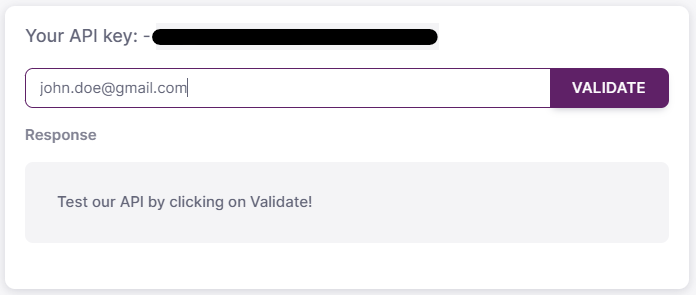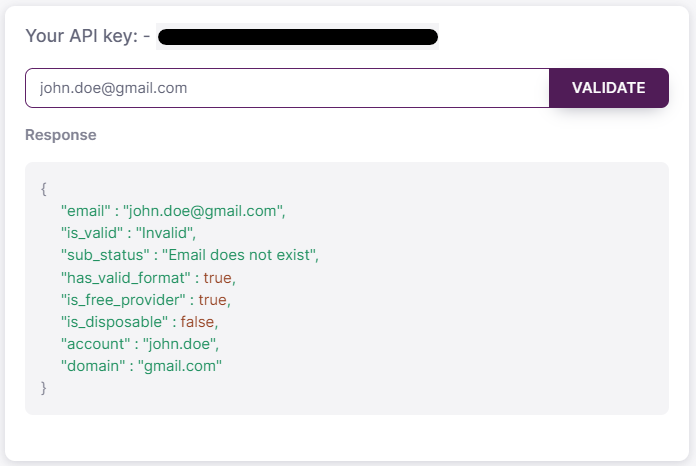HOW DOES EMAIL VALIDATION WORK?
TL;DR:
Email validation is essential to confirm the legitimacy and usefulness of email addresses, avoiding errors and issues like spam. It helps maintain clean email lists and preserve a high sender reputation. Verification tools work without sending emails, assessing the syntax, domain, and email delivery capability of addresses. Verification is crucial to ensure emails reach inboxes and maintain a good relationship with internet service providers, preventing spam and reputation issues.
What Is the Purpose of Email Validation?
Email validation serves the purpose of confirming the legitimacy and usefulness of an email address. It involves checking for potential errors, such as typographical mistakes, and verifying various key aspects:
- Determining the associated domain, like Gmail or Microsoft Outlook.
- Evaluating the email address's capability to receive messages.
- Identifying if it's a temporary email address.
Proper email validation is essential to maintain a clean email list, which is of utmost importance in the context of identity theft and spam traps to ensure the reliability of email communications.
Why Is Email Address Verification Necessary?
The need to validate email addresses lies in its role in maintaining a healthy email account and preserving a high sender reputation. Sender reputation, also known as sender score, is the metric used by Internet Service Providers (ISPs) to determine the legitimacy of your emails.
A positive sender reputation increases the likelihood of your emails reaching recipients' inboxes. Conversely, a damaged sender reputation jeopardizes email success. There are several factors that can harm sender reputation, such as sending unexpected emails that lead recipients to unsubscribe. Ensuring email content aligns with reader expectations and following a consistent sending schedule are essential practices to safeguard sender reputation.
Many elements influence sender reputation: spam complaints, spam traps, sending history, engagement, and unsubscribes. However, bounce rate stands out as a prominent factor.
How Do Email Verification Tools Work Without Sending Messages?
Email verification tools operate without the need to send emails, which prevents potential harm to sender reputation and email delivery capability. They follow a multi-step verification process:
- Syntax and Format Evaluation: Initially, these tools perform a check to assess the correctness of the email address in terms of syntax and format. This step identifies errors like extra "@" symbols or other discrepancies.
- Domain Examination: This stage involves examining the domain associated with the email address to verify its existence and operational status. This is essential as domains can expire or undergo changes that may invalidate email addresses.
- Email Ping: Email verification services use the SMTP protocol to ping the email address's server, assessing its existence and its ability to accept incoming emails. A positive response confirms the email address's validity, while a negative response indicates its non-existence.
These tools allow effective email validation while avoiding potential issues associated with sending emails for verification purposes.
How to Verify an Email Address Without Sending a Message?
Sending an email to verify someone's address can potentially harm your sender reputation and email delivery capability. You never know how many emails might bounce. The safest way to verify email addresses is to use email verification tools like Valid Email.
If you want to validate emails, you can sign up for free on Valid Email to get an account. With this account, you'll receive an API key that authenticates you in the API and allows you to make requests.

Once registered, you can see your API key in the dashboard, along with an input field where you can enter the email you want to validate.

By clicking on "Validate," the API checks on its servers whether the entered account is a valid one or not.

Conclusion
In conclusion, email validation plays a crucial role in maintaining clean email lists and preserving a high sender reputation in the world of email. By verifying aspects like syntax, domain, and email delivery capability, it ensures the legitimacy and usefulness of an email address. This practice is essential to ensure that emails reach recipients' inboxes, avoiding the spam folder and maintaining a good relationship with internet service providers. Email verification tools, which operate without sending messages, allow effective validation without jeopardizing sender reputation or email delivery capability.